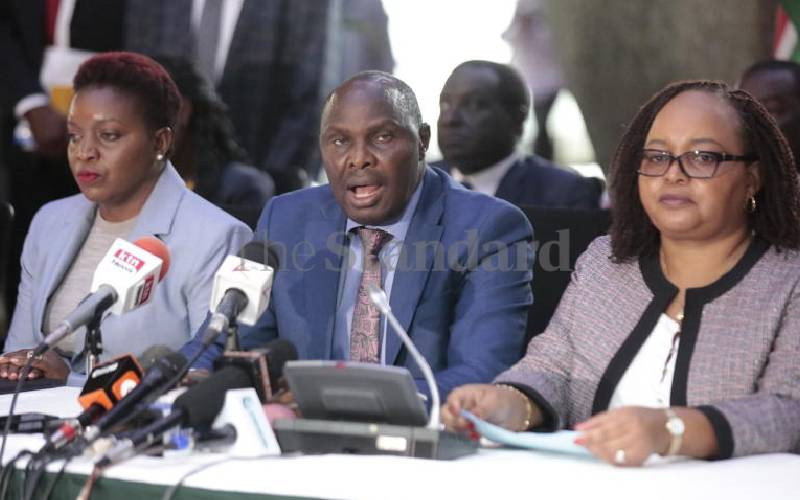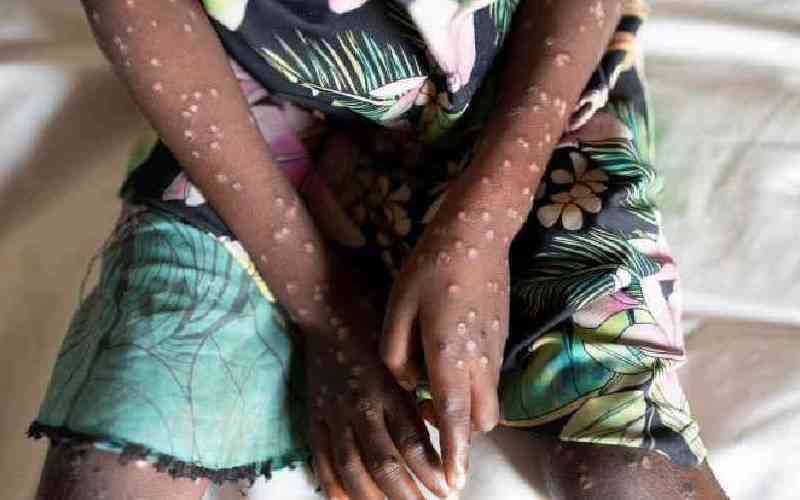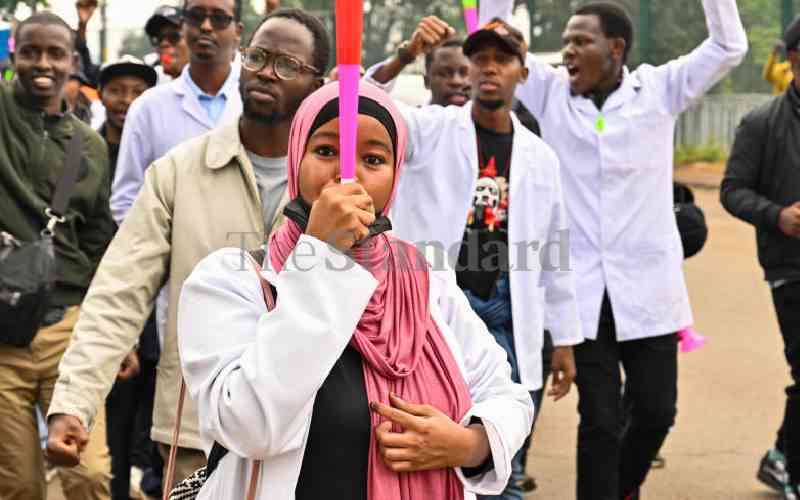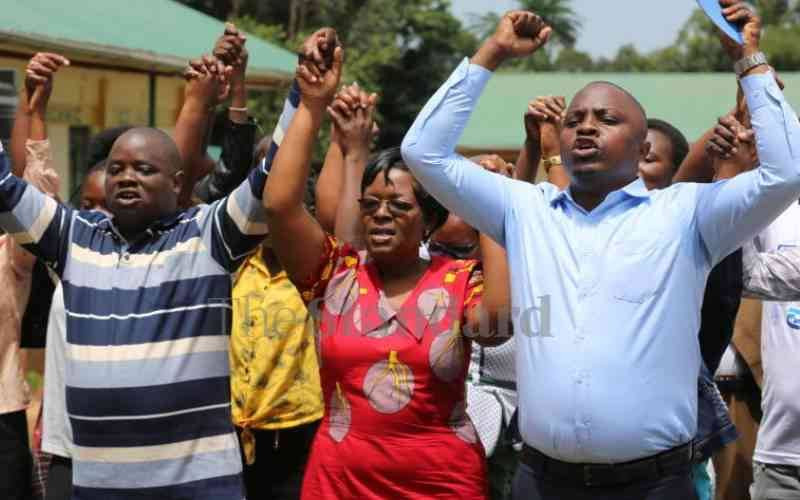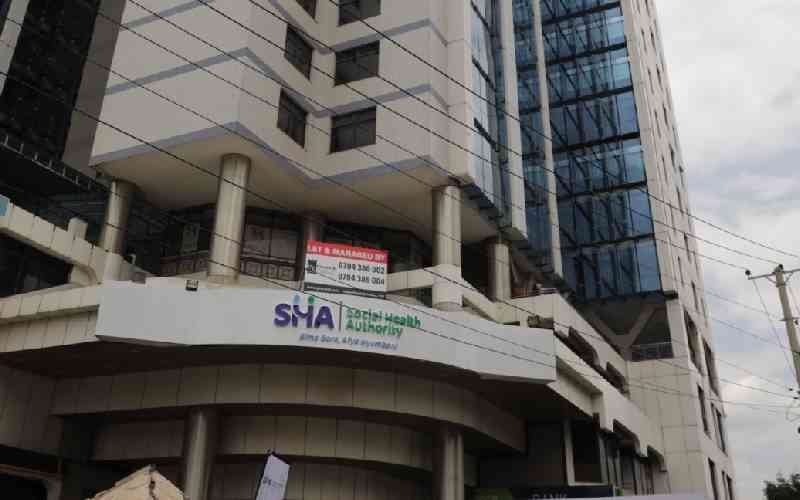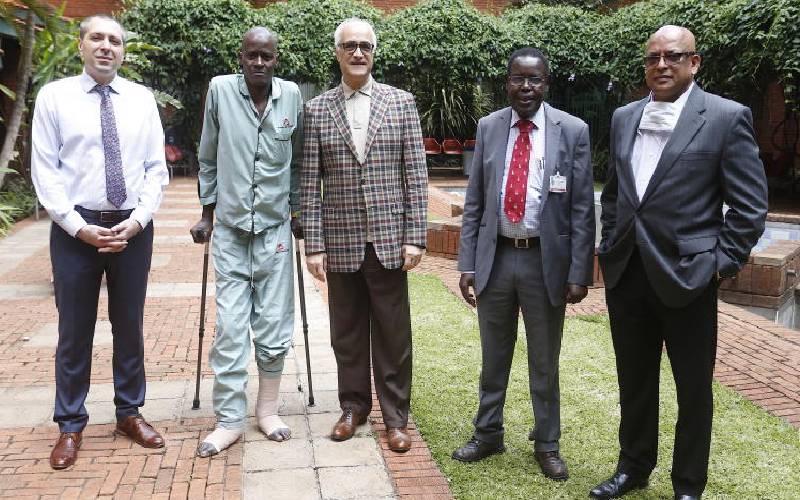
From left: Radovan Boca, assistant professor and consultant plastic surgeon, Fredrick Kalama, Shawn Bolouki, Aga Khan University Hospital CEO, Parmenas Oroko, orthopaedic surgeon and Sunil Basavaraj at the hospital. [Wilberforce Okwiri, Standard]
No one in his village thought Fredrick Kalama could survive the disease that had left him with deep wounds on both legs.
The 53-year-old father of one could hardly walk or even sit upright for 12 years due to the wounds that slowly ate into his flesh.
Many could not believe their eyes, therefore, when Kalama arrived at his Minyali home in Tongaren Constituency over the weekend, walking upright albeit on crutches.
There were no signs of the smelly discharge that would soil bandages and the wounds were neatly dressed.
Kalama, who looked healthier, was released from the Aga Khan Hospital in Nairobi where he spent three weeks with top notch medical specialists investigating his condition through numerous examinations.
The hospital came to his aid after The Standard highlighted his plight on February 20.
“I am happy my condition has improved thanks to the doctors who attended to me at the Aga Khan Hospital and the institution’s management which came to my rescue,” Kalama told The Standard.
Not even his wife Catherine could believe her husband had made such huge strides towards full recovery.
Kalama says most of his friends and even relatives had given up on his recovery.
“I knew they were right, my condition was deteriorating until about three weeks ago when I received a call from Aga Khan to go there for specialised treatment. It sounded like a miracle; they were a godsend,” he said.
Kalama was first treated at many hospitals in Trans Nzoia, but his condition never improved. An earlier diagnosis at one of the hospitals indicated he was suffering from osteomyelitis, a bone ailment that can occur if a bacterial or fungal infection enters the bone tissue.
But specialists at Aga Khan Hospital ruled out long standing bone infection after numerous tests.
Parmenas Oroko, an orthopaedic surgeon at the hospital, said initial X-Ray assessment showed the patient may have had infection in his bones, but further assessments ruled out that possibility.
“We did many tests at the time including MRI scans, special CT scans and other tests which showed the bones were not infected, rather the appearance in the bones was as a result of a reaction that can come from venous insufficiency,” said the doctor.
“If the venous drainage from a particular part of the body is not good, then the bone can react in such a way that it looks as if it is infected. Several tests have been done and several specialists have seen Kalama, including two vascular surgeons, a cardiac surgeon, cardiologist and hematologist to find out what his main problem is.”
According to Dr Oroko, chronic venous insufficiency was the main problem, as shown by tests.
“The blood drainage from the leg is not optimum, and because of this, the patient has had wounds around his leg which have not healed for long. It means the venous drainage is not good,” noted the doctor.
Besides, the specialists discovered growth in Kalama’s veins and because of that, he could not have been operated on to cover the wounds.
“The patient has been evaluated and diagnosis made, and the plan of treatment has been agreed between a number of specialists. He would require rehabilitation, care at a health facility near his home and further assessment and treatment here at our hospital,” said Oroko.
Sunil Basavaraj, a cardiothoracic and vascular surgeon at the facility, confessed that Kalama’s case was complex.
“The basic problem was that he had swelling and wounds on both legs. After ruling out the possibility of chronic ulcers on the legs and swelling due to long standing osteomyelitis that had not been treated, a vascular surgeon was called in to rule out whether there was any vascular involvement,” Dr Basavaraj said.
He said a venous study as well as an ulterior one were conducted.
“The ulterior study was normal but the venous study showed that there was sludging of the deep veins, which indicated that there was some thrombus (blood clot in the vascular system) going on in the deep venous system, an indication of a venous return problem on both legs,” he said.
The specialists would sit to deliberate and agree on the next mode of treatment, to see how Kalama’s wounds can heal and how the swelling would come down.
According to Basavaraj, their investigations also revealed that superficial veins in the patient’s legs had a clot and was not active, hence compromising flow of blood.
“In a human body, if one vein blocks there are numerous collaterals that can open up but if the deep veins are clogged, it can be disastrous. However, that was not the scenario in Kalama’s case,” he said.
The specialists opted to manage the patient conservatively after the tests revealed chronic venous insufficiency.
“We went through several literature and put him on the right medication, which he has been on for almost 10 days now and the swelling has marginally come down and the wounds are better,” said Basavaraj.
Kalama will be expected to continue with treatment for a month or two under close supervision of the specialists.
“Ultimately he may need some treatment to cover the wounds. At this point the combined treatment plan we have put him on over time has brought positive outcome for the patient,” Basavaraj said.
 The Standard Group Plc is a multi-media organization with investments in media platforms spanning newspaper print
operations, television, radio broadcasting, digital and online services. The Standard Group is recognized as a
leading multi-media house in Kenya with a key influence in matters of national and international interest.
The Standard Group Plc is a multi-media organization with investments in media platforms spanning newspaper print
operations, television, radio broadcasting, digital and online services. The Standard Group is recognized as a
leading multi-media house in Kenya with a key influence in matters of national and international interest.

